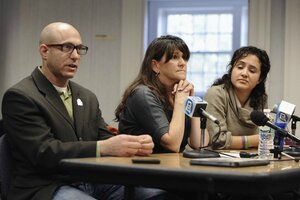Adam Lanza report: How system and personal failings led to Newtown massacre
A review of the circumstances leading up to the Sandy Hook Elementary School shooting in Newtown, Conn., in 2012 lists many instances when Adam Lanza’s troubled mental state and fascination with violence were overlooked or ignored.

Jeremy Richman, left, and his wife Jennifer Hensel, center, parents of Sandy Hook Elementary school shooting victim Avielle Richman, and Nelba Marquez-Greene, right, mother of victim Ana Marquez-Greene address the Sandy Hook Advisory Commission Nov. 14, 2014, in Newtown, Conn. The parents made presentations on ways to better address mental health, school safety and gun violence prevention.
Jessica Hill/AP
A report on Adam Lanza, who carried out the mass shootings nearly two years ago at Sandy Hook Elementary School in Newtown, Conn., was released Friday by the state’s Office of the Child Advocate.
The office was charged with reviewing the circumstances leading up the tragic event in order to develop recommendations for improvements in the public health system.
The authors were careful to emphasize that no one action or circumstance can be linked directly to the shootings – which resulted in the deaths of 20 grade school students and 6 educators – also noting that individuals with mental illness rarely act out violently.
“There is no way to adequately explain why AL was obsessed with mass shootings and how or why he came to act on this obsession. In the end, only he, and he alone, bears responsibility for this monstrous act,” the report notes.
But the extensive review, they said, highlighted the need “to identify and assess youth from a very young age, the importance of effective mental health and educational service delivery, and the necessity of cross-system communication amongst professionals charged with the care of children.”
The report summary enumerated 37 key findings. Among them:
- Lanza exhibited developmental challenges in early childhood and received special education services in elementary school.
- His social-emotional challenges were not adequately addressed.
- He showed early indications of a preoccupation with violence, which appear to have gone unaddressed by schools and possibly his parents as well.
- When his anxiety increased and he was on “homebound” status for students too disabled to attend school, the district provided little surveillance during that school year (8th grade).
- Professional recommendations that he receive extensive special education and therapeutic supports to address obsessive-compulsive disorder and anxiety went largely unheeded.
- Once he was diagnosed with Asperger’s, his education plan did not adhere to guidelines for educating students with autism spectrum disorder.
- He progressively deteriorated in the last years of his life, eventually living in virtual isolation. There are no records of mental health treatment after 2008.
- He “became increasingly preoccupied with mass murder, encouraged by a cyber-community – a micro society of mass murder enthusiasts with whom he was in email communication.”
- He had engaged in recreational use of firearms while growing up, and he retained access to firearms and high-capacity ammunition magazines even as his mental health deteriorated.
- Lanza planned and carried out the massacre in the wake of his mother (his sole caregiver for many years) planning to move them out of Sandy Hook, “perhaps stimulated by fears of leaving the ‘comfort zone’ of his home.” But it does not appear that he was “actively psychotic” during the last days of his life.
The report offers more than a dozen recommendations for schools, families, health providers, governments, and others. Among them:
- There should be universal screening for behavioral health and developmental impairments from birth to age 21.
- Care of children with significant behavioral and mental health challenges should be better coordinated among schools, education providers, and medical providers.
- Better support is needed for parents with such children. But also, systems need to be willing to step in if parents are unwilling or unable to provide needed interventions.
- Schools need better funding to provide a range of therapeutic and other services.
- Special education teams should be allowed to take a holistic approach to a child’s needs rather than focusing on a “primary disability.”
- More capacity needs to be developed to support children and young adults with autism spectrum disorders, particularly when they also have mental health challenges.
In a joint statement Friday, the leaders of the American Federation of Teachers and the Connecticut and Newtown affiliated unions said: “We hope the report will be used to secure adequate and much-needed mental health services, including necessary training and supports, in the schools and throughout the community…. As we approach the second anniversary of these tragic events, we believe Newtown is moving in the right direction, and we pray nothing derails the healing process.”

